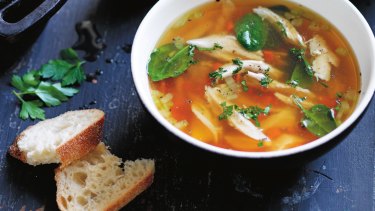They might be a better alternative than takeaway, but Australian research suggests meal kit subscriptions could be better aligned with dietary guidelines.
Researchers at the University of Sydney analysed the nutritional value of five of the most popular meal kit services, concluding the meals are healthier than standard takeaway although simple ingredient swaps would make them a healthier choice.
Meal kits can be better for you than take-away but season with care.
The study, published in Nutrients, assessed 12 meals from international market leaders HelloFresh and MarleySpoon, Australian "paddock to plate" offering Pepper Leaf, affordable local option Dinnerly and Thomas Farms Kitchen, owned by Adelaide-based Thomas Foods International.
The kits were found to all contain good amounts of vegetables. Thomas Farms Kitchen contained an average of 2.3 serves per meal (the lowest of the group), meanwhile HelloFresh came out on top with an average of 3.1 serves.
However, HelloFresh was also found to be the meal kit with the highest salt content, with an average meal containing almost double the sodium content of the other brands, which averaged over 30 per cent of a person's recommended dietary intake for sodium.
The meals assessed from HelloFresh also did not contain any wholegrains. The kits that fared best on this front came from Dinnerly, with 60 per cent of its meals' serves of grains delivered as wholegrains.
Fat content was high across the board, although the type of fat differed: Thomas Farm Kitchen meals contained an average of 22 grams of saturated fat, compared to six grams in a MarleySpoon or Pepper Leaf meal. On the kilojoule front, MarleySpoon, Dinnerly and Pepper Leaf's meals each had around 2900 kilojoules, whereas the average Hello Fresh or Thomas Farms Kitchen meal contained 4000 kilojoules.
The recommended daily kilojoule intake for an adult is 8700.
A HelloFresh spokesperson said they "appreciated" the study's findings and "as with all feedback, [they] will take it on board to continuously improve [their] product".
"Our recipes are developed based on customer feedback and we know our spice blends and other sources of sodium are very popular with customers," they said. "We provide the nutritional information for all our recipes six weeks in advance, allowing customers to choose meals with this information in mind."
Dr Alice Gibson, co-author of the study, said "really simple changes" could make these kits healthier. Her team largely thought the meals were healthy and only realised the amount of salt and fat added once they performed the nutritional analysis.
"A significant contribution to the salt (sodium) from these meal kits came from salt added during cooking – in a few of the meals this was up to five times," she said.
"It is usually no more expensive to use lower salt varieties of products such as sauces and canned tomatoes and this would not affect the easiness or the expiry of the meal kits – as this would be predominantly determined by the fresh produce."
Dr Gibson said she would recommend people who use meal kit subscription services do not add salt because a recipe tells them to, be careful with every "drizzle" of oil and avoid meals which contain fatty or processed varieties of meat such as sausages or bacon.
"Even if the recipe doesn't, because it probably won't, trim all the visible fat off," she advised.
"Meal kits can have a role in your diet, but they're not an everyday thing," said accredited practising dietitian Shivaun Conn, who has been working as a clinical dietitian for 17 years. She said stock cubes and less lean cuts of meat often drive up the salt and fat.
Although Ms Conn said she would prefer her clients cook their meals from scratch, she recognises people go through "busier periods" and meal kits can be a good option for those times.
"Unlike the meals which are already frozen, you can have more control over what you're eating," she said. "They suggest things like adding salt and cooking with butter, but you have the flexibility to just add pepper and use less fat or a substitute."
Source: Read Full Article

